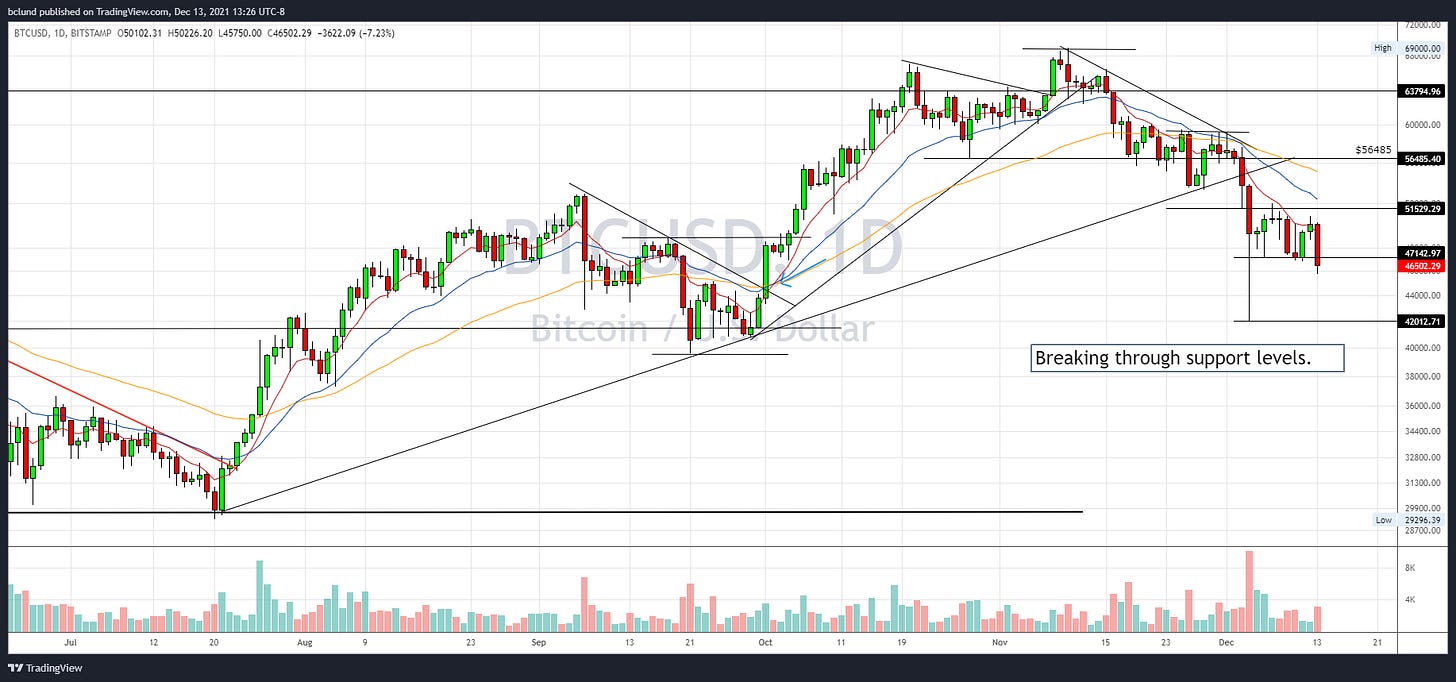My friend Brian Lund is a chart geek. He sent out some charts today. He thinks crypto needs a bounce, or it will get ugly. I won’t show all the charts, you can subscribe for that. But, here are the two major cryptos Bitcoin and Ethereum
If you aren’t a chart geek, Ethereum is through support levels and should trade down significantly, maybe dropping by 50%. Bitcoin has a big support level at $36k, but below there it gets ugly.
The Slope of Hope is a permabear, and a chartist as well. He is an excellent trader and is an excellent counterbalance to any permabulls you listen to. Here is a link to his post, “Death of A Meme Stock”. I also found this post good to ponder.
When Meme stocks, meme coins, and cryptocoins that formerly had no top run out of gas, it tells you something. Like Tim at Slope of Hope says, “animal spirits” might be on the wane.
Reddit’s WallStreetBets might be injecting a lot into the conversation when it tells “apes” and “retards” to hold and comes up with funny memes to hold stocks that pit retail against Wall Street, but the market is the market.
At some point, fear takes over. I was looking at my Helium ($HNT) holdings and they have lost roughly 50% of their value from the top. If I was scalping Helium, I would have been out long ago. I believe in the long term vision of what they are doing so I am not selling, but I am not catching a falling knife either.
I don’t scalp markets anymore or swing trade. I am just not that active because I can’t focus on it. Maybe next year as my other occupations wind down. But, I always watch the market.
We are in a weird choppy market zone. I can list all the “bad” that is going on in the world. I know Jim Cramer of CNBC says this is the strongest economy in history but he’s wrong and everyone on the street knows it.
However, when I look at certain things there is evidence of some economic activity. Mostly it’s in home prices. Here is an article saying a home in San Francisco just sold for $1MM over the asking price. In my home state of Nevada, we are seeing home appreciation like crazy. Other states like Florida, Texas, Arizona, Idaho, Tennessee, South Carolina, North Carolina, and states that are similar are seeing the same.
The talk on housing values scares me. I have scars from 2007-09. They haven’t healed.
My friend Professor John Burrows of Chicago Booth posted this. It’s one of the more interesting things I have read on crypto.
Tons of money is flowing to crypto right now. Billions. There are crypto hedge funds, crypto venture funds, crypto-focused this and that. I am long-term bullish crypto for a lot of reasons, but the amount of money being tossed around in the space is going to have a comeuppance and I think it will leave a mark.
If you were at the crypto table in 2012-13, you did well. It’s not to say there won’t be more huge companies built on crypto in the future, or are being built today, there are. But, when a lot of money gets thrown in one place at one time valuations go up and discipline goes out the window.
Crypto is also going to get regulated. But, that doesn’t stop the appreciation of an asset in isolation.
Do you know what brings it back? Bear markets. Remember those? I do.
The biggest thing that weighs on my mind is the Federal Reserve. They have pursued an easy money policy since 2007. That initially changed risk preferences from bonds and real estate to stocks fueling a rally. But, it went further, crypto happened and hot money that might normally find its way into other sectors of the economy went into crypto. Plus, endowments and other big pools of capital switched up their investing preferences from stocks to alternative investments as they had fear of missing out. Some big pools of capital made commitments to alternatives after 2003 and made out big.
The cost of capital is basically free. Hence, the change in overall preferences.
The problem with some of those preferences is that there is a lack of liquidity. Even if you aren’t a HODL’er, you might wind up being just that because when you look for the exit door, there isn’t one. Getting out of a thinly traded asset is like being in a hotel ballroom with 1000 people when a fire breaks out and there is only one exit door.
My friend Yra Harris wrote a blog on December 12 that you should read.
This situation, though, reflects the ACADEMIC response of running inflation HOTTER FOR LONGER TO ENSURE MORE JOBS AND MITIGATING THE PAIN OF INCREASED DEBT TAKEN ON BY HOUSEHOLDS, FIRMS and GOVERNMENT OVER THE LAST DECADE. It was the work of Kenneth Rogoff and Carmen Reinhart back in 2012 that theorized that running higher inflation for a few years would be a positive thing to repair financial balance sheets. This idea became de rigueur and as the COVID pandemic led to more debt as unemployment grew
Academics can be idiots. One thing I respected of my professors at Chicago Booth is when they taught some theory is if they had real world stuff to back it up. Sometimes they asked the class for input. It was the reverse of the “it works in practice but does it work in theory” joke at Chicago.
Inflation alone isn’t exactly terrible depending on why you have it. If it’s true growth and demand for plentiful goods and services, it’s a first world problem. The problem with the inflation we are experiencing today is it is not due to growth and demand for plentiful goods and services. It’s because supply chains are still broken and the government has helicoptered free money everywhere. People are still avoiding going back to work for goodness sake and in many cases, shitty totalitarian government policy is keeping their incentive to work low.
Remember, after 2008 the talk was fear of deflation? While I agree deflation is more debilitating than inflation, those of us that remembered the 1970s always cast a wary eye on the Fed when it comes to money creation. There are only a couple of sure-fire cures for rampant inflation, higher interest rates, and lower government spending. As a child of that era, our generation knows the Fed is always behind the curve when it comes to taking action on things like inflation or moving monetary policy to stop bubbles from forming.
I know Milton Friedman isn’t in vogue anymore, but the iron laws of economics that he elucidated do not bend. Print more money, increase government spending, you get more inflation…..eventually.
Why didn’t we have inflation under Obama when he really ramped up spending?
Inflation isn’t purely at the feet of the Federal Reserve and the government. It’s not some sort of effect from pulling a puppet’s string. There are a lot of factors. Obama inherited the after-effects of the real estate bubble popping. There was a lot of slack in supply chains across the world to use up before it became inflationary. Also, as long as your economy is growing a percentage point or two above inflation growth, people don’t notice it and things should be okay. It’s when shocks happen that things get messed up.
Trump was no fiscal conservative either. He ramped up spending and we still didn’t have inflation. Why?
We had a tremendous amount of growth and the world had turned supply chains into incredibly lean and efficient lines of production. We are able to churn out more goods without a huge increase in the marginal cost to produce them. Given worldwide competition, the marginal profit stayed relatively stable.
Then came Covid.
Professor John Cochrane has an excellent post on Covid and Inflation. He also discusses 2008 and other economic periods. Cochrane is a freshwater economist, so he’d be at odds with Krugman, Brad DeLong, and the salt water school. If you ever encounter them, ask them where they got the dollar they created to pay for the programs they advocate for. TANSTAAFL.
An excerpt:
First, we can just look at what politicians said. In 2008 and following years, the Administration continually offered stimulus today, but promised deficit reduction to follow. One may take those promises with a grain of salt. But at least they bothered to try. This time there was no talk at all about deficit reduction to follow, no policies, no plans, no promises about how to repay this additional debt. Indeed, long-run fiscal policy discussion became focused on how low interest costs, r<g, and modern monetary theory allow painless fiscal expansion. The discussion of tax hikes in the spring and summer of 2021 focused entirely on paying for some of the ambitious additional spending plans, not repaying the Covid helicopters.
Second, much of the expansion was immediately and directly monetized and sent to people as checks. The previous stimulus was borrowed, and funded government spending programs that have to gently work their way into people's incomes. Following 2008, M2 did not rise as much as debt. The QE operations were mostly confined to a switch of bank assets from Treasury debt to reserves, as we see from the contrast between the monetary base (currency + reserves) and M2 in Figure 2. (Note the base is on a different scale.)
Cochrane also chastises the Fed and says the policy in 2020 and 2021 were an institutional failure. No surprise to any child of the 1970s.
Cochrane concludes:
A successful inflation stabilization always combines fiscal, monetary, and microeconomic reform, in a durable new regime that commits to pay its debts. 1980 was such an event, not just a period of high interest rates. High interest rates can drive down inflation temporarily in all these models, giving time for the fiscal (1986 tax reform) and microeconomic reforms to take effect. In their absence, inflation takes off again. A new inflation stabilization would have to be such an event as well, but in the face of at least four times larger debts, larger structural deficits, and a more deeply entrenched regulatory regime.
He’s right!
Imagine if we had a responsible fiscal policy in the US. No deficits, or at least smaller deficits. Revamped social programs and the safety net. Think instead of transfer payments, vouchers that allowed people to be free to choose! Suppose we ended the czarist Regulatory pogroms that assault business hourly and replaced it with regulations that recognized costs/opportunity costs. We might be able to climb out of this whole mess.
But, instead, we have this guy in charge. He is calling for more spending that is unprecedented, and higher taxes.
I might remind everyone to study up on their Milton Friedman. He basically proved mathematically what we all know. It’s ingrained into our humanism. Human incentive is a hard thing to overcome. This is why communism and socialism that is held up by Democrats today as a cure will never ever work.
I think 2022 will be a very hard year to be bullish in any asset class. I think that for crypto, it will be a washout year. Batten down the hatches. Crypto is acting like a risk on market but I think it should risk off.
Milton also said this:













There is a big disconnect between inflation and interest rates, and a lot of people seem to think it can persist. I doubt that very many people ('people' including institutions) are going to be buying 30-year Treasuries at 1.81%, or even at 3%, if sustained inflation looks to be in say the 5-6% range.
One thing that may exert an upward push on interest rates, is the worldwide vogue for 'clean energy'. Wind and solar are far more capital-intensive than are conventional power plants; even nuclear is more capex-intensive than are fossil fuels. Much of this will be debt-financed, either by government or by private/semiprivate organizations. There is so much momentum behind this thing now that even if there are Republican wins in 2022 and 2024, there will still be huge outlays for 'green energy'.
Has to be one of your best posts. The gaggle of speculators seemed to flood into crypto, then weed stocks, then back to crypto, to meme stocks, back to crypto and now off to...where? These were the cocktail waitresses in 2007 who had 3 no- doc mortgages and were flipping houses. Now it's Reddit bros. But when you hear half the parents at your kid's soccer game talking about Ethereum, is that necessarily a bad thing? It could very well be. With a "nothing to see here" message being white washed on the walls of the media on the cusp of an election year, my guess is this flow moves to equities, though we know that won't last, no matter how pretty Jim Cramer says the picture is.